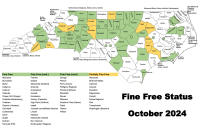Up Moses Creek: Thrashers make a home on Berry Island
 Like the mockingbird, the brown thrasher, seen here, mimics the songs of other birds. Tim Carstens photo
Like the mockingbird, the brown thrasher, seen here, mimics the songs of other birds. Tim Carstens photo
The sight of a fox standing in the yard would not have made my eyes open any wider that morning than the two brown thrashers did when I saw them out the window.
Not that brown thrashers are uncommon. There are about as many of them around as there are mockingbirds, and like mockingbirds, they loudly mimic the songs of other birds. But, fox-like, they are hard to see. A mockingbird will perch in full view on a lamppost to sing, but usually all I see of a thrasher is a brown blur shooting between thickets. Thrashers are bigger than mockingbirds too, with dark-streaked breasts, sharp, down-curving beaks, a very long tail, and piercing yellow eyes.
But right there outside my study window that morning was a pair of thrashers standing in the grass, with twigs in their beaks. Then they flew into a nearby clump of holly bushes and started building a nest. The hollies are part of a tangle of blueberry, blackberry, beautyberry, pokeberry and chokeberry growing in our yard. We call it Berry Island. And the nest they were making was just five feet off the ground. I quietly called Becky to join me. It was June 17, and we had a bird’s eye view from the start.
For three days we watched the thrashers build the nest, using twigs and rootlets and fibrous bark. Picture a football cut in half and lodged in branches with the point stuck down. That was the size and shape of the nest. They stuck a few dead leaves on the finished product for camouflage, then the female settled in to lay her eggs. We rarely saw her after that until early in July, when she began to forage in the yard for insects to feed her young. The chicks stayed out of sight, but we knew what greeted the mother when she returned with a grub or caterpillar in her beak—a nest full of gaping red mouths.
One morning, hearing a clamor in the hollies, I looked out to see titmice and chickadees in a tizzy. It was the kind of ruckus that says “snake.” In years past when we’ve heard these birds gather to scold like that, there’s often been a black rat snake climbing toward a nest. I’d catch the reptile and release it in the woods, but not before giving it a lecture: “Eat other birds if you have to, but not ours.”
The thrasher parents came immediately, their eyes piercing the undergrowth, ready to strike at any predator. Thrashers are even known to draw blood from humans who come near their young. Then suddenly the noise stopped, and the small yard birds left. Maybe they were simply testing their version of an early warning system. Or they might have been crying wolf just for the fun of it—the way humans sometimes do. Or perhaps it was the copperhead they were harassing. It lives in Berry Island too, but it doesn’t tend to climb. Whatever the reason, the thrashers calmed down and went back to feeding their young.
Related Items

- Thrasher’s nest: For three days, Burt Kornegay watched the thrashers build their nest, which is seen empty in this picture. Burt Kornegay photo
Three days ago, both parents started flying continuously back and forth from the nest. The time for fledging must be near! They were so intent on finding insects that if we walked past, they kept right on foraging. I bet we looked at Berry Island a hundred times a day.
Then, late on the afternoon of July 11, while I was canoeing on the Tuckaseegee and Becky was at a concert in Cashiers — the only three hours this week the two of us have been gone from home at the same time — it happened. Whether by coincidence or cunning, in those few hours the thrashers seem to have nudged their young into flight.
We didn’t know it had happened, but the next morning, mist still hanging on the ridge, I noticed how still Berry Island was, the stillest I’d seen it in 26 days. The hollies did flare into life when the wren family showed up, the young’ns hopping from branch to branch, while the female chided and the male gave his bugle call, “We’re here.”
And later, the thrasher pair appeared. Maybe we’d see the chicks fledge after all. But it must have been Empty Nest Syndrome that drew them back for one last look at the old haunt. They had youngsters to guard and feed. In a minute they were gone. It’s not just humans who “can’t go home again.”
Finally, the sun rose high above the ridge and shined into my window so hot I had to move. Feeling the old, familiar avian anticipation inside me turning into Empty Yard Syndrome, I walked out with Becky to Berry Island. We eased our way in, parted the branches, and looked into an empty nest.









